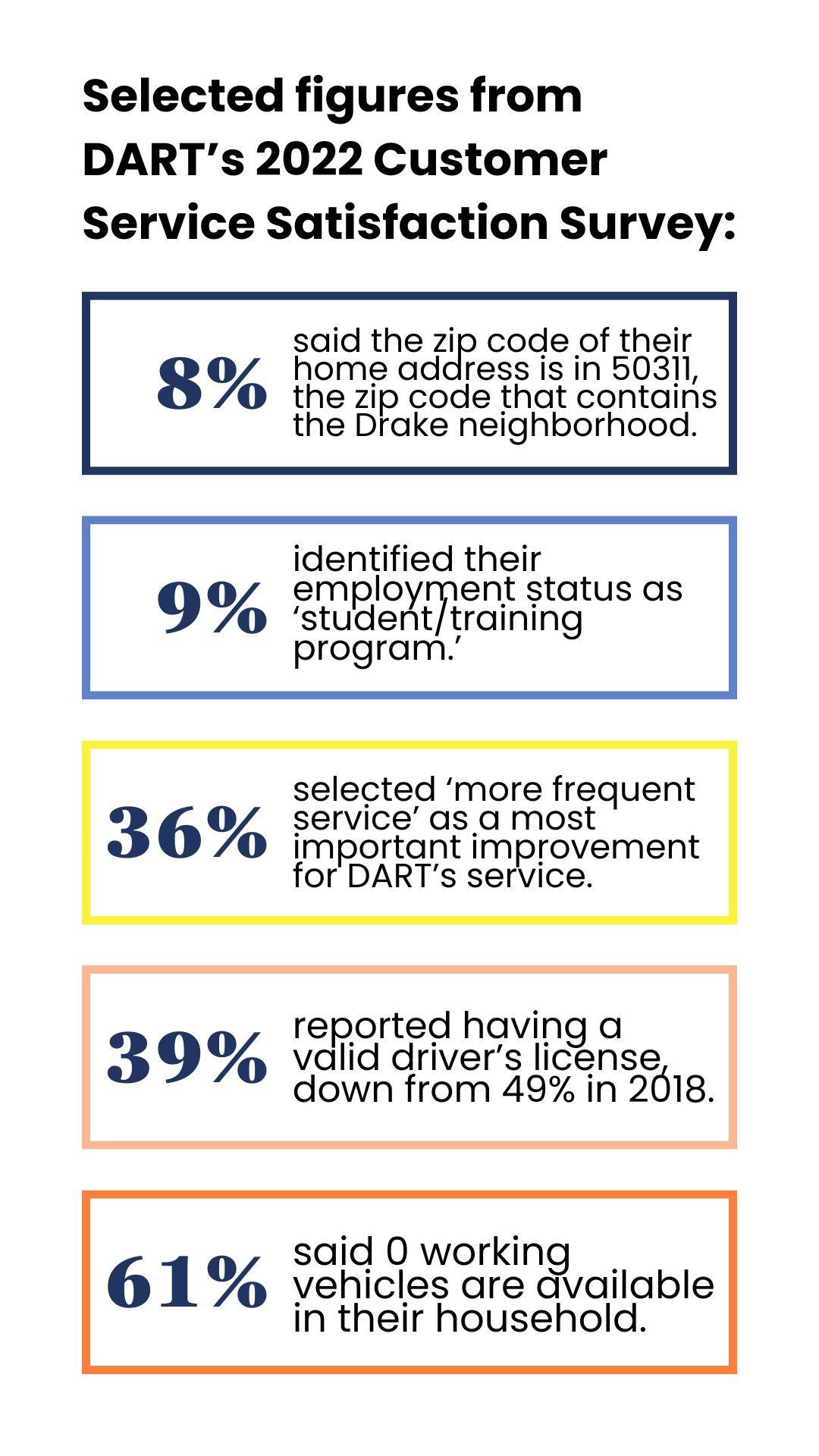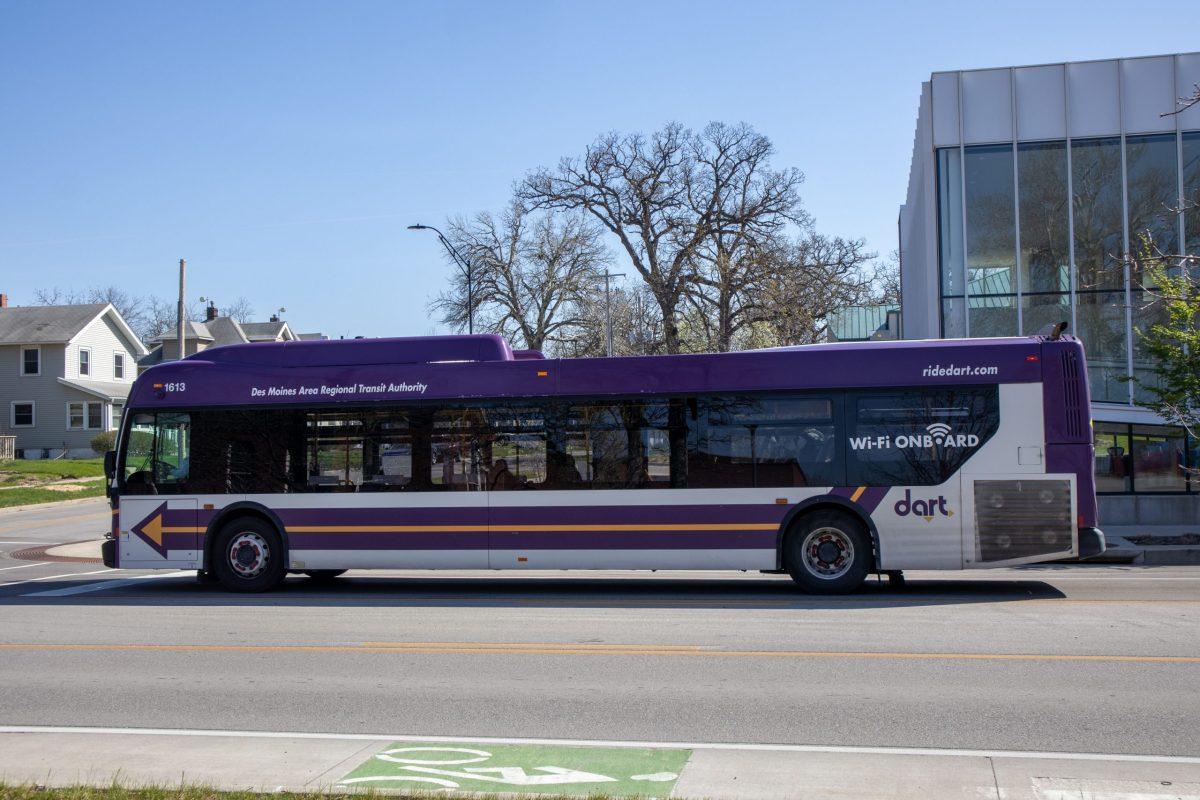Amid budget difficulties, Des Moines Area Regional Transit — better known as DART — may decrease the frequency of routes that service the Drake campus.
In a February press release, DART proposed two budget scenarios, one of which involves decreasing all of its services by 20 to 25 percent. This includes decreasing the frequency of numerous routes, ending service one hour earlier on weekdays and running all routes hourly during the weekends.
The scenario outlines the following changes affecting the Drake neighborhood: Routes 3 and 60, which stop on University Avenue and are often used by students to get downtown or to the Ingersoll area, would run every 30 minutes during “peak times” rather than every 20 minutes; and Route 5, often used by students to get to the the Merle Hay Mall, would run every 60 minutes during peak times rather than every 50 minutes.
Peak times vary by day and route but mostly align with the Des Moines Public School’s schedule, Sarah Welch, a representative for DART, said in an email.
“20 minutes can make the difference in an hour’s worth of planning,” Drake professor Cody Dolinsek said. “…If you’re a professor like I am, you have to rethink how you schedule riding time. You have to rethink how you schedule when to check emails, when to meet with students. Again, if you’re driving yourself, you can do things pretty much whenever you want.”

DART faced with taxation issues
DART attributes its budget deficit — which will hit $2.7 million by fiscal year 2025 — to greater expenses and decreased revenue. On the expense side, DART has paid more for fuel and vehicle parts due to inflation and more in wages to keep up with the market, according to a budget presentation provided to The Times-Delphic.
DART is funded by the City of Des Moines and property taxes. Welch said that 62% of DART’s budget is funded with local property taxes, compared to 50-80% of “most transit operations across the nation.” According to the DART budget presentation, unlimited access programs like Drake’s and passenger fares only accounted for about 10% of DART’s total revenue in 2023.
Another contributor to DART’s budget issues: Legally, DART has reached a cap in what it can collect through property taxes from the city of Des Moines. In 2021, DART started phasing in a new taxation formula in which communities that receive the most DART service contribute the most local funding — mostly in the form of property taxes — to the transit organization. Since 70% of DART’s services are in Des Moines, Des Moines contributes the most in property taxes — more than an Iowa statute allows the agency to collect.
To mitigate the impact of this shortfall, Des Moines has contributed additional money through its Park and Ride Fund for the past three years. The city has said it will provide $1.5 million from its general fund to DART next fiscal year and $2 million the following year, but this is still less than DART budgeted for under the new formula.
“The proposed service cuts do not correlate with ridership levels or the amount of farebox revenue we’ve been able to collect during and after the pandemic,” Welch said. “The service cuts are the result of DART receiving less local revenue than what is necessary in order to maintain existing service.”
Without a solution to its funding woes, DART will see an estimated $2.7 million deficit in fiscal year 2025. DART has proposed two scenarios to prevent such a deficit: either the Des Moines City Council votes to increase its franchise fee (a tax on gas and electric bills) up to 2.5% to fund public transit or finds additional funding for DART, or the transit organization will cut its services in the manner described above.
“If it weren’t for the fact that I have access to bus service, I wouldn’t be able to get regularly to my job,” Dolinsek told city leaders at a city council meeting.
Of the 716 Des Moines residents who responded to DART’s January survey on possible service cuts, 64% said “city leaders should increase the franchise fee and find additional revenue to expand services to offer residents better public transit options than today.” 27% said “city leaders should increase the franchise fee to keep the level of services that DART provides today.” Only 9% said “city leaders should not pass the franchise fee and DART should cut services.”
“The people I know that use DART are using it very, very frequently. It’s like an everyday thing,” Vice President of Student Life Breckyn Lyons said during a Student Senate meeting on March 21. “I’ve used it a couple of times to go downtown. It’s been nice because I don’t have a car here. The impact would definitely be felt on campus.”
Students interested in voicing their opinion on DART’s funding can contact their elected officials — such as the Drake area’s city council member, Chris Coleman — and urge them to support the proposed increase to Des Moines’ franchise fee; provide public comment at a DART Board of Commissioners meeting; or submit their story to DART.
DART said it’s still determining if and when it will hold public meetings on the possible service cuts based on how much local funding is committed by the end of May.
Drake ridership recovering post-pandemic
Thanks to the University’s unlimited access program with DART, Drake students, faculty and staff can ride DART for free by presenting their Drake ID.
Since 2020, DART has recorded an annual average of 30,679 Drake rides, according to data the transit organization provided to the TD. DART can’t track individual riders, so this number represents the number of times DART’s drivers recorded the use of a Drake ID.
Like DART ridership as a whole, Drake ridership is still below pre-pandemic levels but has increased in the past two years. Last fall (September – November) Drake students and employees averaged 3,300 individual trips per month.
| Fiscal Year | Drake Rides |
| 2018 | 41,925 |
| 2019 | 40,268 |
| 2020 | 27,398 |
| 2021 | 15,414 |
| 2022 | 25,993 |
| 2023 | 33,073 |
Note: DART’s fiscal year starts in July and ends in June. For example, fiscal year 2020 started on July 1, 2019 and ended June 30, 2020.
Drake “has no plans to discontinue” contract with DART, Nate Reagan says
Drake’s current three-year contract with DART will expire on June 31 of this year. Drake pays DART $44,000 annually to provide Drake ID-holders with “unlimited access” to local routes (ex. routes 3, 5 and 60) and express routes, which operate to and from downtown Des Moines during the morning and evening rush hours.
“It’s still too early. We do an annual renewal, so we have no plans to discontinue that renewal,” Chief of Staff Nate Reagen said. “This will be a good opportunity to wait and see. Obviously, what happens with their plan — and based on the outcome — will give us more information about what that looks like. We have no plan to discontinue.”
While Drake doesn’t lobby on behalf of DART, the institution supports public transportation and tries to promote its use among students, according to Reagen.
“Woven into the fabric of being an anchor institution is being supportive of public transportation because that’s essential to a thriving community,” Reagen said.
Conversations on DART funding continue to unfold. Details therein are the latest available information as of April 18, 2024.
Update: On April 18, the city’s Metropolitan Planning Organization awarded DART $3.6 million in one-time funding from its Carbon Reduction Program. The DART Commission must now decide whether to use more federal funding for operating expenses. Welch said the organization does “not yet know if there will be a reduction in service,” and in the meantime, DART has paused plans to collect public input on service cuts.








